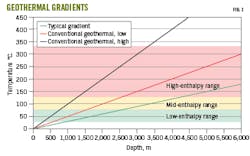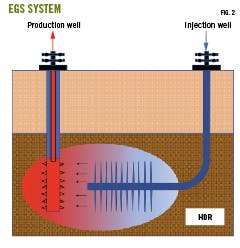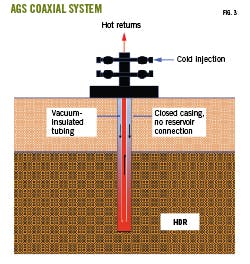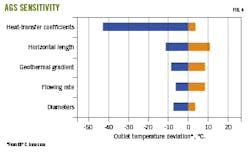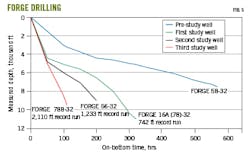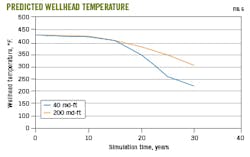New geothermal wells exploit unconventional technology
New geothermal systems are being developed to provide energy outside traditional geothermal sources. Conventional systems are hydrothermal, producing hot water or steam directly from reservoir sources. They require locations where sourcerock contains high heat, porosity, permeability, a seal (caprock), and water. These locations exist in only a handful of tectonic and volcanically active areas in California, Indonesia, Iceland, Philippines, Turkey, New Zealand, Mexico, Italy, Kenya, and Japan.
Conventional geothermal wells are typically drilled in hard and abrasive volcanic and rigid sedimentary formations, typically composed of granite, and target fractures or faults to obtain necessary permeability for hot water or steam production. The wells are usually drilled until circulation is lost, indicating intersection of a fault or fracture, then completed openhole or with a slotted liner to produce hot water or steam.
By contrast, unconventional enhanced geothermal systems (EGS) create fracture networks in otherwise impervious hot dry rock (HDR), analogous to unconventional oil and gas exploitation. After stimulation, water or CO2 working fluid is injected into the well to return as heated fluid or gas. An alternative advanced geothermal system (AGS) uses a closed loop, keeping the working fluid within the pipe.
In either unconventional geothermal system, geothermal gradient is the main driver of efficiency. Electricity generation typically requires rock at high enthalpy with minimum 125-150° C. bottomhole temperature. Hydrothermal geothermal applications have high geothermal gradients (50-100° C./km), and these temperatures are accessible at shallower depths than in wells drilled through typical gradients of about 30° C./km (Fig. 1). Significant problems will be faced drilling and completing high enthalpy reservoirs in unconventional geothermal wells, and these difficulties scale inversely with geothermal gradient.
The systems are not limited to direct conversion of heat to electrical energy, however. Sources in the low- to mid-enthalpy range (50-125° C.) serve lower temperature agriculture, space heating, and binary powerplant requirements. In this capacity, significantly more reservoirs around the word are available for exploitation than in traditional hydrothermal geothermal applications.
EGS
EGS places an injector well near a producer well and targets HDR. Wells are connected through naturally occurring fractures or hydraulically stimulated fractures (Fig. 2). Working fluid pumped from surface through the fracture network (below fracture pressure) absorbs thermal energy from the rock through convection and returns to surface where it is used for heating or electrical generation, depending upon return temperatures. Los Alamos National Laboratory demonstrated this technology in 1977 at Fenton Hill, Nev. Controllable parameters were production temperature (drilling depth), reservoir size (injected volume), and operating pressure (flow rate).
EGS stimulations have typically been performed with single fractures from vertical or slanted wells. Because the fracture network is created with injection pressures above minimum horizontal stress, induced fractures are presumed to propagate from naturally occurring fractures and extend roughly planar to the far field, unless intersected by a fault.
The limited fracture network created by classical single-zone EGS stimulation leads to injection fluid traversing a small number of dominant pathways. A stimulation experiment at the Soultz-sous-Forêts EGS project in the Upper Rhine Graben, for example, showed fluid injecting into the formation at only four locations along 500 m of open wellbore. Limited injection pathways are substandard for EGS because they excessively cool rock, limit heat transfer, and result in premature thermal breakthrough. The limited fracture network also reduces allowable injection flow rate, reducing volumetric heat recovery.
Multistage fracturing, adopted from unconventional wells, creates a larger fracture network using cluster spacings of 20-50 ft along the entire wellbore. Far field measurements through image logs, fiber optic networks, or coring are unavailable for multi-frac EGS completions. The typical extent of created fracture networks in EGS, therefore, is unknown. With sufficient imaging, faults can be avoided while still creating a robust fracture network around them. The application of multistage fracturing to EGS is in its infancy, with no commercial projects to date.
AGS
AGS does not rely on permeability of the rock or created fractures. The system is a closed loop, and fluid never contacts the rock. Thermal conduction transfers heat from reservoir to well.
AGS systems can either contain two wells connected at the toe, with one well serving as the injector and the other as producer as in EGS, or a single coaxial well with cold fluid injected down the tubing-casing annulus where it heats up along the well path and returns as hot fluid up the tubing (Fig. 3).
The coaxial design requires vacuum-insulated tubing to prevent heat transfer from hot fluid rising inside the tubing to cool fluid descending in the annulus. High flow rates minimize heat loss, but also minimize residence time in the annulus for heat conduction from the reservoir. Tubing and casing sizes are optimized to provide maximum annular area for residence time while still providing acceptable tubing ID for economic heat production and acceptable friction pressure drops.
One method to optimize heat capture is to operate the well in circulation mode before startup or periodically during production without extracting heat from the produced fluid. This cycle warms up casing, cement, and surrounding upper rock with reservoir heat to prevent heat loss in the cool working fluid as it descends to the reservoir during heat production, when heat is extracted from the working fluid at surface through heat exchangers.
Livescu and Dindoruk thermally modelled a coaxial AGS system repurposed from an existing decommissioned hydrocarbon well drilled to 3,000 m. The results showed that tubing and casing diameters have less impact on wellhead flowing temperature than lateral length, geothermal gradient, flow rate, and heat transfer coefficients between formation and annulus (Fig. 4). Heat transfer was the most important factor, with up to twofold increase in produced temperature calculated based on a range of realistic coefficients.
Unfortunately, the formation heat transfer coefficient is the only factor that cannot be engineered, and it is not well understood in the reservoir. Using best-guess values for overall heat transfer coefficients may result in highly inaccurate heat and electric power estimates. Livescu and Dindoruk state that they “are not aware of any study for directly and accurately measuring these coefficients either in the laboratory or in the field.”
AGS has several advantages over EGS. Fluid circulation pathway is obviously better defined and controlled, stimulation costs are eliminated, and there are no seismic issues within the closed system. Several EGS systems have been cancelled over seismicity, and there are multiple examples in the US where large-scale water injection has led to increased seismicity.
To date, no commercial closed loop system exists, but an R&D pilot project is ongoing in Canada.
Drilling, stimulation difficulties
Drilling problems for geothermal include high temperatures and rock strengths. In general, full economic potential for geothermal requires reservoir temperatures above 150° C. Conventional geothermal projects with reservoirs up to 300° C. are not uncommon. Rocks are typically granites with uniaxial compressive strengths typically above 25 kpsi. Hole sizes need to be large for effective thermal transfer, typically 8.5 in. or larger, increasing drilling costs and risk.
Measure while drilling (MWD) and logging while drilling (LWD) tool temperature limits are below 200° C., and commercial electronics cannot go higher than that. Flasks and cooling mechanisms are currently being investigated to get around these limitations. High flow rates through the bit, necessary for large hole sizes, may provide additional cooling for electronic components.
Mud systems for high-pressure high-temperature (HPHT) oil and gas well drilling may be adapted to geothermal drilling. Recent developments in oil-based and water-based mud systems have pushed mud operating limits to 180° C and 165° C, respectively (Oil & Gas Journal, May 2, 2022, pp. 44-49). While these limits are too low for the mud to remain static in typical geothermal drilling, previous geothermal and HPHT projects used surface chillers and high flow rates to keep mud within the stability window.
Drilling losses in naturally occurring, highly fractured formations risk traditional geothermal drilling. In the event of losses, fluid loss additives must be carefully selected to be thermally stable in the geothermal environment. Managed pressure drilling (MPD) and pressurized mud cap drilling (PMCD) can be adapted from oilfield drilling to address these concerns. These systems also maintain high circulation rates, even when making and breaking connections, continuously cooling downhole components and mud.
Bit penetration in hard rock is being addressed by the Frontier Observatory for Research in Geothermal Energy (FORGE) at Milford, Utah, sponsored by the US Department of Energy. The project’s primary aim is to enhance EGS.
Texas A&M University quantified physics-based drilling parameters for improved rate of penetration (ROP) at FORGE. By establishing a mechanical specific energy (MSE) baseline for each rock section, ROP was maximized by increasing WOB and rpm until MSE deviated from baseline. Drilling results at FORGE showed that most ROP limitations were due to drilling disfunctions instead of excess WOB. These dysfunctions include bit resonance, where lateral vibrations create drag in the bottom hole assembly (BHA), disrupting rotating motion of the bit, and bit whirl.
Other improvements included a bit redesign based on wear patterns to extend bit life and high spurt-loss water-based fluids to produce more brittle rock failure. Personnel were continuously trained throughout the project to identify and correct bit dysfunction. Fig. 5 shows that, over a three-well program, instantaneous ROP increased 400% and footage per bit 200% as compared with a previously drilled well.
Completion difficulties included the mentioned need for far-field fracture monitoring and accurate fracture models for EGS environments. Most geothermal wells are drilled in igneous or metamorphic formations that do not have strong sedimentary formation capstones. In an EGS granite modelling study, McClure et. al suggest that fractures should grow upward given EGS’s vertically homogeneous formation properties and the linear trend of stress and pore pressure with depth in EGS targets. They note, however, that this was not observed in EGS projects in which microseismic was available, showing fractures growing radially or laterally oblong, perpendicular to the minimum horizontal stress.
In fracture models, increasing fracture toughness drives fractures vertically. Fracture toughness is the stress intensity factor which describes the entire stress field at the crack tip in a linear-elastic material. It is neither an intrinsic property of rock (like uniaxial compressive strength) or reservoir (like stress) but a coupled solution. It is a tunable parameter in fracture models that needs field data for calibration, which is not yet available for unconventional geothermal environments.
McClure et. al prevented excessive upward growth by limiting fracture toughness and increasing leakoff and viscous pressure drop factors. They also defined horizontal fractures with two orders of magnitude more conductivity than vertical fractures. While these are reasonable assumptions given the limited amount of information available for far-field fracture geometries in granite and general behavior of multiple fractures in shale, without additional field projects which quantify far-field effects, realistic modelling parameters for multistage fracture geometries in granite are still largely unknown.
Also unknown is unpropped fracture conductivity in granite. Proppant can be used to support conductivity, but most proppant will eventually dissolve under typical EGS conditions, and high-strength, chemically inert proppant could add considerable cost to the completion. Given the strength of granite, hydraulic fractures are likely to be self-propping if asperities are created between fracture facies with lateral offset before closure. Stress shadow effects will aid this offset, but laboratory and field data are not yet available to fully understand this process. McClure et. al. estimated conductivity based on a 0.02-in. zero stress-aperture, a fracture strands correlation to account for multiple fracture strands in a narrow band behaving as a single fracture, and a pressure-dependent term for aperture closure.
The base-case fracture treatment in McClure’s model used no proppant. Fracture geometry was numerically simulated for the injection wells with water injection at 80 bbl/min for 4 hr per 200 ft stage. Each stage had eight perforation clusters with two 0.4-in. diameter perforations per cluster. The production well was not stimulated. Base fracture conductivity was 40 md-ft (constant, without stress dependency) but fractures were allowed to open with reservoir cooling.
Wells were modelled as an EGS injector-producer doublet at 13,900-ft true vertical depth (TVD). Initial injector design included four 200-ft stages spaced 750 ft from the producer in toe-to-heel orientation. The production well was modelled as a non-stimulated openhole. Bottom hole temperature was 482° F. (250° C.), resulting in a thermal gradient of 54° C./km, which was higher than the Earth’s average geothermal gradient and at the lower end of conventional hydrothermal geothermal gradients. Wellbore friction was included in the simulations, and both wells have 8.5-in. inner diameter.
During circulation, injection was restricted to 2,300-psi maximum well head pressure (WHP) which was below the minimum horizontal stress to avoid fracture propagation. The producer was restricted to 500-psi WHP. Simulations were run across a range of well spacings, injection-production rates, and number of fractures (cluster spacing). Injection was always higher than production to account for leakoff into the surrounding formation. Fluid was injected at 116° C.
Results of the model study are not quantitative given the many assumptions involved but provide useful qualitative results to understand how an EGS system works. Given the input base parameters, the model converged to the tightest cluster spacing available in its parameters (50 ft) to create more fractures, increase flow rate, and improve heat sweep efficiency. Fig. 6 shows wellhead water temperature at the producer during 30 years of simulation.
The cooling front propagated through some fractures more rapidly than others based on random variance in fracture conductivity specified in the simulation. Cooling around fractures reduced stress along neighboring fractures, and opened localized fractures, increasing their conductivity based on temperature-dependent stresses in the reservoir. At about 19 years of simulation time, thermal breakthrough occurred where injected fluid channeled through high conductivity pathways at rates too high to fully transfer heat from the reservoir. The model calculated electricity generation based on wellhead pressure, and electricity generation dropped commensurately.
A model run with 200 md-ft fracture conductivity showed shallower temperature dropoff, resulting in about 300° F. (148° C.) wellhead temperature at 30 years compared with about 220° F (104° F). for the 40 md-ft fracture conductivity model. The model’s optimizer took advantage of the lower pressure drops through higher conductivity fractures to increase well spacing and delay thermal breakthrough. These results indicate that fracture conductivity could be an important parameter for long-term heat recovery and argue for development of proppants compatible with long-term high heat and saline water exposure.
The modelling results indicate that EGS systems can generate power at economic rates using known hot granite reservoir parameters and typical shale well multiple-fracture completion designs, with the caveat that a higher-than-normal geothermal gradient was used for the simulations. Further work is required to refine all assumptions in the model.
Unconventional geothermal limitations
Aside from drilling problems for deep wells in granite formations under average thermal gradients, the modelling study by McClure et al. demonstrates that produced heat will decline in EGS or AGS systems over time, analogous to oil and gas well decline. Not only does fluid breakthrough reduce produced heat in EGS systems, but rock heat conduction further limits long-term operation of either EGS or AGS systems.
Rocks are slow to cool, but also slow to warm. Much latent heat can be extracted out of the rocks in these unconventional geothermal wells, but the working fluid cools rocks at the same time. While the earth provides an almost unlimited supply of heat relative to the contact area of the injection well, heat transfer from the source through rocks occurs at too slow a rate relative to rate heat removal by the injection-production pair to maintain indefinite heat production. The system can produce heat for a long time (up to 20 or 30 years in McClure et al. simulations) but eventually the near-wellbore area will be cooled below economic heat extraction levels.
Reservoir heat recharge during shut-in will take roughly the same amount of time as it did to cool the rocks. This means that, in either EGS or AGS cases, new wells will have to be continuously drilled to tap new heat zones in the reservoir while old “heat depleted” zones recharge. The timing of this shut in-new drill cycle depends on field-specific factors. Livescu and Dindoruk demonstrated that basic heat transfer coefficients are the most important and still unknown quantity for AGS and EGS success. PVT properties, long-term corrosion resistance, and scaling tendencies are other unknown quantities that need attention, and unconventional geothermal is only beginning to address these issues.
Bibliography
Brommer, M.B. and O’Sullivan, J.M., “The current status of deep geothermal energy,” First Break, Vol. 38, No. 10, October 2020, pp. 51-54.
Clegg, J. and Krase, S., “New-Generation Geothermal Wells - How the Upstream Oil and Gas Industry Can Bring Its Experience to Bear,” IADC/SPE-208747-MS, IADC/SPE International Drilling Conference and Exhibition, Galveston, Tex., Mar. 8-10, 2022.
Dupriest, F. and Noynaert, S., “Drilling Practices and Workflows for Geothermal Operations,” IADC/SPE-208798-MS, IADC/SPE International Drilling Conference and Exhibition, Galveston, Tex., Mar. 8-10, 2022.
Livescu, L. and Dindoruk, B., “Subsurface Technology Pivoting from Oil and Gas to Geothermal Resources: A Sensitivity Study of Well Parameters,” SPE-209227-PA, SPE Production & Operations, publication not yet assigned, 2022.
McClure, M, Kang, C., and Fowler, G., “Optimization and Design of Next-Generation Geothermal Systems Created by Multistage Hydraulic Fracturing,” SPE-209186-MS, SPE Hydraulic Fracturing Technology Conference and Exhibition, The Woodlands, Tex., Feb. 1-3, 2022.
Potier, N., Hinderer, J., Riccardi, U., Ferhat, G., Calvo, C., Abdelfettah, Y., and Bernard, J-D., “New Results on the gravity monitoring (2014-2017) of Soultz-sous-Forêts and Rittershoffen geothermal sites (France),” Geothermal Energy, Vol. 6, No. 19, 2018.
Sask, D., Graham, P., and Nascimento, C., “Optimizing Geothermal Heat Extraction for End of Life Oil & Gas Wells Using a Transient Multiphase Flow Simulator,” SPE-208928-MS, SPE Canadian Energy Technology Conference, Calgary, Mar. 16-17, 2022.
Schmidt, R., “A Microcrack Model And Its Significance to Hydraulic Fracturing And Fracture Toughness Testing,” ARMA-80-0581, 21st US Symposium on Rock Mechanics (USRMS), Rolla, Mo., 1980.
About the Author
Alex Procyk
Upstream Editor
Alex Procyk is Upstream Editor at Oil & Gas Journal. He has also served as a principal technical professional at Halliburton and as a completion engineer at ConocoPhillips. He holds a BS in chemistry (1987) from Kent State University and a PhD in chemistry (1992) from Carnegie Mellon University. He is a member of the Society of Petroleum Engineers (SPE).
